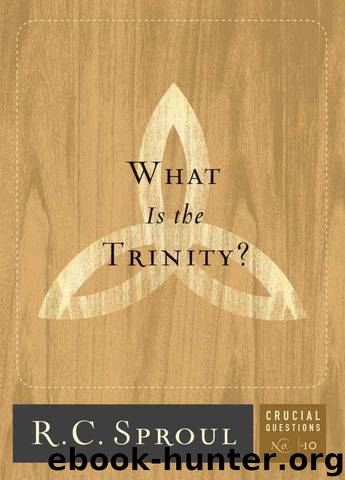What is the Trinity? by R. C. Sproul

Author:R. C. Sproul
Language: eng
Format: azw3
Publisher: Reformation Trust Publishing
Published: 2011-07-01T05:00:00+00:00
MONOPHYSITISM AND NESTORIANISM
The Council of Nicea represented a watershed moment for the church. For the most part, it put an end to monarchianism, but two new errors with respect to the nature of Christ soon developed.
The first was taught by a man named Eutyches. He was the first to articulate the monophysite heresy, which seems to appear anew in every generation. The term monophysite consists of the now-familiar prefix mono, meaning “one,” and physite, which comes from the Greek phusis, meaning “nature.” So the word monophysite literally means “one nature.”
Throughout the ages, the church has said that God is one in essence, being, or nature, and three in person. It has said just the opposite with respect to the person of Christ, who is said to be one person with two natures—one human and one divine. But Eutyches denied this truth. The monophysite heresy taught that Jesus had only one nature. Eutyches viewed Jesus as having one “theanthropic” nature. The word theanthropic comes from the Greek anthropos, which means “man or mankind,” and the prefix thea, which means “God.” So theanthropic is something of a mongrelized term that combines Greek words for God and for man. Eutyches was saying that in Christ there is only one nature—a divinely human nature, or, to express it the other way around, a humanly divine nature. But Eutyches’ view was manifestly a denial that Christ had two natures, one human and the other divine. In fact, the monophysite heresy sees Christ as neither God nor man, but as something more than man and less than God. He represents a kind of deified humanity or a humanized deity. So the distinction between humanness and deity was obscured in this thinking.
But not only did the church have to fight against Eutyches and his monophysite heresy, it had to resist the twin heresy of Nestorianism, named after its founder, Nestorius. Nestorius basically said that one person cannot have two natures; if there are two natures, there must be two persons. Therefore, since Christ had both a divine nature and a human nature, He was a divine person and a human person co-existing. This was the opposite of the monophysite distortion. In the Nestorian heresy, the two natures of Christ were not merely distinguished, they were totally separated.
It is the prerogative of the theologian to make fine distinctions; that is what theology is about. Therefore, I tell my students, “One of the most important distinctions you will ever learn to make is the one between a distinction and a separation.” We say that a human being is a duality—he has a physical dimension and a non-physical dimension, which the Bible describes in terms of body and soul. If I distinguish a person’s body from his soul, I do no harm to him, but if I separate his body from his soul, I not only harm him, I kill him. By not grasping the difference between distinguishing and separating, Nestorius essentially destroyed the biblical Christ.
This truth is useful at many points in biblical interpretation.
Download
This site does not store any files on its server. We only index and link to content provided by other sites. Please contact the content providers to delete copyright contents if any and email us, we'll remove relevant links or contents immediately.
Signature in the Cell: DNA and the Evidence for Intelligent Design by Stephen C. Meyer(2880)
Real Sex by Lauren F. Winner(2875)
The Holy Spirit by Billy Graham(2783)
The Secret Power of Speaking God's Word by Joyce Meyer(2761)
The Gnostic Gospels by Pagels Elaine(2403)
Jesus by Paul Johnson(2232)
Devil, The by Almond Philip C(2207)
23:27 by H. L. Roberts(2144)
The Nativity by Geza Vermes(2120)
Chosen by God by R. C. Sproul(2058)
All Things New by John Eldredge(2054)
Angels of God: The Bible, the Church and the Heavenly Hosts by Mike Aquilina(1871)
Angels by Billy Graham(1846)
The Return of the Gods by Erich von Daniken(1843)
Knowing God by J.I. Packer(1727)
Jesus of Nazareth by Joseph Ratzinger(1710)
Evidence of the Afterlife by Jeffrey Long(1707)
The Gnostic Gospel of St. Thomas by Tau Malachi(1684)
How To Be Born Again by Billy Graham(1674)
